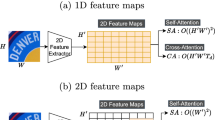Abstract
Visual saliency models have been introduced to the field of character recognition for detecting characters in natural scenes. Researchers believe that characters have different visual properties from their non-character neighbors, which make them salient. With this assumption, characters should response well to computational models of visual saliency. However in some situations, characters belonging to scene text mignt not be as salient as one might expect. For instance, a signboard is usually very salient but the characters on the signboard might not necessarily be so salient globally. In order to analyze this hypothesis in more depth, we first give a view of how much these background regions, such as sign boards, affect the task of saliency-based character detection in natural scenes. Then we propose a hierarchical-saliency method for detecting characters in natural scenes. Experiments on a dataset with over 3,000 images containing scene text show that when using saliency alone for scene text detection, our proposed hierarchical method is able to capture a larger percentage of text pixels as compared to the conventional single-pass algorithm.
Access this chapter
Tax calculation will be finalised at checkout
Purchases are for personal use only
Similar content being viewed by others
Notes
- 1.
We are planning to make the database freely available in near feature.
References
Coates, A., Carpenter, B., Case, C., Satheesh, S., Suresh, B., Wang, T., Wu, D., Ng, A.: Text detection and character recognition in scene images with unsupervised feature learning. In: International Conference on Document Analysis and Recognition (ICDAR), pp. 440–445 (2011)
Yao, C., Bai, X., Liu, W., Tu, Z.: Detection texts of arbitrary orientations in natural images. In: Computer Vision and Pattern Recognition (CVPR), pp. 1083–1090 (2012)
Mishra, A., Alahari, K., Jawahar, C.V.: Top-down and bottom-up cues for scene text recognition. In: International Conference on Computer Vision and Pattern Recognition (CVPR), pp. 2687–2694 (2012)
Lee, J.J., Lee, P.H., Lee, S.W., Yuille, A., Koch, C.: AdaBoost for text detection in natural scene. In: International Conference on Document Analysis and Recognition (ICDAR), pp. 429–434 (2011)
Epshtein, B., Ofek, E., Wexler, Y.: Detecting text in natural scenes with stroke width transform. In: Computer Vision and Pattern Recognition (CVPR), pp. 2963–2970 (2010)
Uchida, S.: Text localization and recognition in images and video. In: Doerman, D., Tombre, K.(eds.) Handbook of Document Image Processing and Recognition (to be published in 2013)
Sun, Q.Y., Lu, Y., Sun, S.L.: A visual attention based approach to text extraction. In: International Conference on Pattern Recognition (ICPR), pp. 3991–3995 (2010)
Walther, D., Itti, L., Riesenhuber, M., Poggio, T.A., Koch, Ch.: Attentional selection for object recognition - a gentle way. In: Bülthoff, H.H., Lee, S.-W., Poggio, T.A., Wallraven, Ch. (eds.) BMCV 2002. LNCS, vol. 2525, pp. 472–479. Springer, Heidelberg (2002)
Elazary, L., Itti, L.: A Bayesian model for efficient visual search and recognition. Vision. Res. 50(14), 1338–1352 (2010)
Torralba, A., Murphy, K.P., Freeman, W.T., Rubin, M.A.: Context-based vision system for place and object recognition. In: International Conference on Computer Vision (ICCV), vol. 1, pp. 273–280 (2003)
Shahab, A., Shafait, F., Dengel, A.: Bayesian approach to photo time-stamp recognition, In: International Conference on Document Analysis and Recognition (ICDAR), pp. 1039–1043 (2011)
Shahab, A., Shafait, F., Dengel, A., Uchida, S.: How salient is scene text?. In: International Workshop on Document Analysis Systems (DAS), pp. 317–321 (2012)
Uchida, S., Shigeyoshi, Y., Kunishige, Y., Feng, Y.K.: A keypoint-based approach toward scenery character detection. In: International Conference on Document Analysis and Recognition (ICDAR), pp. 918–823 (2011)
Itti, L., Koch, C., Niebur, E.: A model of saliency-based visual attention for rapid scene analysis. IEEE Trans. Pattern Anal. Mach. Intell. (PAMI) 20(11), 1254–1259 (1998)
Koch, C., Ullman, S.: Shifts in selective visual attention: towards the underlying neural circuitry. Human Neurobiol. 4, 219–227 (1985)
Borji, A., Itti, L.: State-of-the-art in visual attention modeling. IEEE Trans. Pattern Anal. Mach. Intell. (PAMI) 35(1), 185–207 (2013)
Judd, T., Ehinger, K., Durand, F., Torralba, A.: Learning to predict where humans look. In: International Conference on Computer Vision, Kyoto, Japan, pp. 2016–2113 (2009)
Treisman, A.M., Gelade, G.: A feature-integration theory of attention. Cogn. Psychol. 12(1), 97–136 (1980)
Otsu, N.: A threshold selection method from gray-level histograms. IEEE Trans. Sys. Man Cybern. 9(1), 62–66 (1979)
Ward Jr, J.H.: Hierarchical grouping to optimize an object function. J. Am. Stat. Assoc. 58(301), 236–244 (1963)
Author information
Authors and Affiliations
Corresponding author
Editor information
Editors and Affiliations
Rights and permissions
Copyright information
© 2014 Springer International Publishing Switzerland
About this paper
Cite this paper
Gao, R., Shafait, F., Uchida, S., Feng, Y. (2014). A Hierarchical Visual Saliency Model for Character Detection in Natural Scenes. In: Iwamura, M., Shafait, F. (eds) Camera-Based Document Analysis and Recognition. CBDAR 2013. Lecture Notes in Computer Science(), vol 8357. Springer, Cham. https://doi.org/10.1007/978-3-319-05167-3_2
Download citation
DOI: https://doi.org/10.1007/978-3-319-05167-3_2
Published:
Publisher Name: Springer, Cham
Print ISBN: 978-3-319-05166-6
Online ISBN: 978-3-319-05167-3
eBook Packages: Computer ScienceComputer Science (R0)




